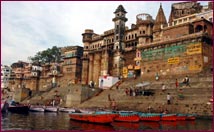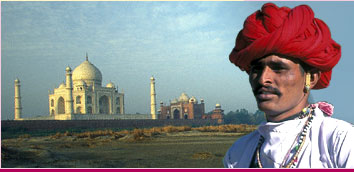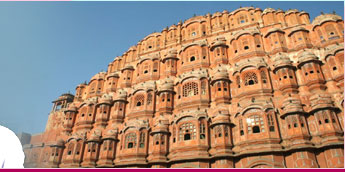Ganges in Varanasi is believed to have the power to wash away the sins of mortals. Ganges is said to have its origins in the tresses of Lord Shiva and in Varanasi, it expands to the mighty river that we know of. The city is a center of learning and civilization for over 3000 years. With Sarnath, the place where Buddha preached his first sermon after enlightenment, just 10 km away, Varanasi has been a symbol of Hindu renaissance. Knowledge, philosophy, culture, devotion to Gods, Indian arts and crafts have all flourished here for centuries. Also a pilgrimage place for Jains, Varanasi is believed to be the birthplace of Parsvanath, the twenty-third Tirthankar.
Vaishnavism and Shaivism have co-existed in Varanasi harmoniously. With a number of temples, Mrs. Annie Besant chose Varanasi as the home for her 'Theosophical Society' and Pandit Madan Mohan Malviya, to institute 'Benares Hindu University, the biggest University in Asia. Ayurveda is said to be originated at Varanasi and is believed to be the basis of modern medical sciences such as Plastic surgery, Cataract and Calculus operations. Maharshi Patanjali, the preceptor of Ayurveda and Yoga, was also affiliated with Varanasi, the holy city. Varanasi is also famous for its trade and commerce, especially for the finest silks and gold and silver brocades, since the early days.
 Varanasi
has also been a great center of learning for ages. Varanasi
is associated with promotion of spiritualism,
mysticism, Sanskrit, Yoga and Hindi language and
honored authors such as the ever-famous novelist Prem
Chand and Tulsi Das, the famous saint-poet who
wrote Ram Charit Manas. Aptly called as the cultural capital
of India, Varanasi has provided the right platform for all cultural
activities to flourish. Many exponents of dance and music have come
from Varanasi. Ravi Shankar, the internationally renowned
Sitar Maestro and Ustad Bismillah Khan, (the famous
Shehnai player) are all sons of the blessed city or have lived
here for major part of their lives
Varanasi
has also been a great center of learning for ages. Varanasi
is associated with promotion of spiritualism,
mysticism, Sanskrit, Yoga and Hindi language and
honored authors such as the ever-famous novelist Prem
Chand and Tulsi Das, the famous saint-poet who
wrote Ram Charit Manas. Aptly called as the cultural capital
of India, Varanasi has provided the right platform for all cultural
activities to flourish. Many exponents of dance and music have come
from Varanasi. Ravi Shankar, the internationally renowned
Sitar Maestro and Ustad Bismillah Khan, (the famous
Shehnai player) are all sons of the blessed city or have lived
here for major part of their livesPlaces to Visit in Varanasi
Being the oldest city of the world and an important Hindu Pilgrimage Center, Varanasi attracts a large number of people from all over the world. For centuries, Varanasi is famous for spiritualism, mysticism, Indian philosophy and Hinduism. All these are reflected in numerous sects, Temples, Ashrams and Ghats. Varanasi is associated not only with Hinduism but also with Buddhism and Jainism. Besides numerous temples, Varanasi also boasts of Buddhist Stupas and Jain Temples. Varanasi is also a mirror of the age-old Indian civilization. The Archaeological Museum at Sarnath houses numerous remains of the past, including the National emblem of India, the Ashoka Pillar.
Since Varanasi is mainly associated with Hinduism, temples form the main attraction. The Ganga Ghats (river fronts) are the main center of religious activities and rituals and also form one of the main attractions of Varanasi. The Alamgir Mosque, blend of the Hindu and Mughal styles of the architecture, is another important attraction of Varanasi. Some of the most important temples of Varanasi are Durga Temple, Vishwanath Temple, Sankat Mochan Temple, Tulsi Manas Temple and the Bharat Mata Temple. The Bharat Mata Temple houses a huge relief map of the whole of Indian subcontinent and Tibetan plateau. Other attractions of Varanasi are the Benaras Hindu University (BHU), the Archaeological Museum, Sarnath, Bharat Kala Bhavan and the Buddhist Stupas and temples at Sarnath.
Chanting of mantras and hymns , the fragrance of incense purifying the air , the refreshing dip in the holy river Ganga , the splashing of water along the ghats and the evening 'aartis' ( worship) , all combine to impart an unforgettable experience ,that is meditative and divine.





